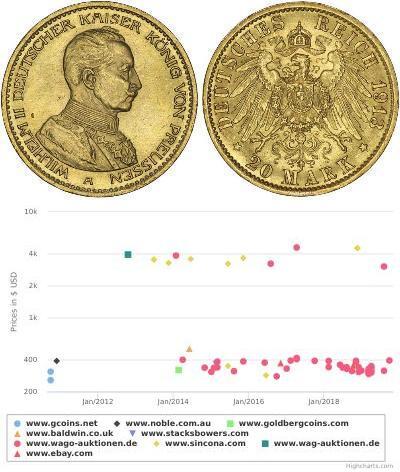(продана за $2.0)
1916, Kingdom of Hejaz, Hussein bin Ali. Countermarked 40 Para Coin. KM-4. R!
Reference: KM-4. Countermark Period: 1916-1920s Denomination: 40 Para (regnal year 5). Condition: Minor greenish deposits, otherwise XF with a VF-XF countermark! Mint Place: Islambol (today´s Istanbul, where the coin was struck) / Mecca (where the countermark was applied). Diameter: 23mm Weight: 6.02gm Material: Nickel
Obverse: Large central countermark "al-Hijaz" over ottoman Tughra of the host coin, which bears the regnal date 5.
Reverse: Large central value (40) in arabic above accession date of the Ottoman Sultan (AH1327).
In the time before 1916 Turkish coins circulated in this region and throughout the Ottoman Empire. When the Turks were thrown out Husein ibn Ali, soon to be King of Hejaz in Mecca, ordered the existing coins to be counterstamped "al-Hijaz" over the tughra of the Sultan, thus effacing the symbol of centuries of Ottoman domination.
Al-Hejaz, also Hijaz (Arabic: الحجاز al-Ḥiǧāz, literally "the barrier"), is a region in the west of present-day Saudi Arabia. It is bordered on the west by the Red Sea, on the north by Jordan, on the east by Najd, and on the south by Asir. Its main city is Jeddah, but it is probably better known for the Islamic holy cities of Mecca and Medina. As the site of Islam's holy places, the Hejaz has significance in the Arab and Islamic historical and political landscape. Historically, Hejaz has always seen itself as separate from the rest of Saudi Arabia. Hejaz is the most populated region in Saudi Arabia; 35% of all Saudis live in Hejaz. Hejazi Arabic is the most spoken accent in the region. Saudi Hejazis are of ethnically diverse origins. Hejaz is the most cosmopolitan region in the Arabian Peninsula. People of Hejaz have the most strongly articulated identity of any regional grouping in Saudi Arabia. Their place of origin alienates them from the Saudi state, which invokes different narratives of the history of the Arabian Peninsula. Thus, Hejazis experienced tensions with people of Najd.
em>.
Hussein bin Ali, GCB (1854 - 4 June 1931) was the Sharif and Emir of Mecca from 1908 until 1917, when he proclaimed himself and was internationally recognized as King of the Kingdom of Hejaz. He initiated the Arab Revolt in 1916 against the increasingly nationalistic Ottoman Empire during the course of the First World War. In 1924, when the Ottoman Caliphate was abolished, he further proclaimed himself Caliph of all Muslims. He ruled Hejaz until 1924, when, defeated by Abdul Aziz al Saud, he abdicated the kingdom and other secular titles to his eldest son Ali.

|
Добавив:
anonymous 2019-11-29 |
1 Шилінг Південно-Африканська Республіка Срібло Поль Крюгер ...
в групі 16 монет / 10 цін
⇑














